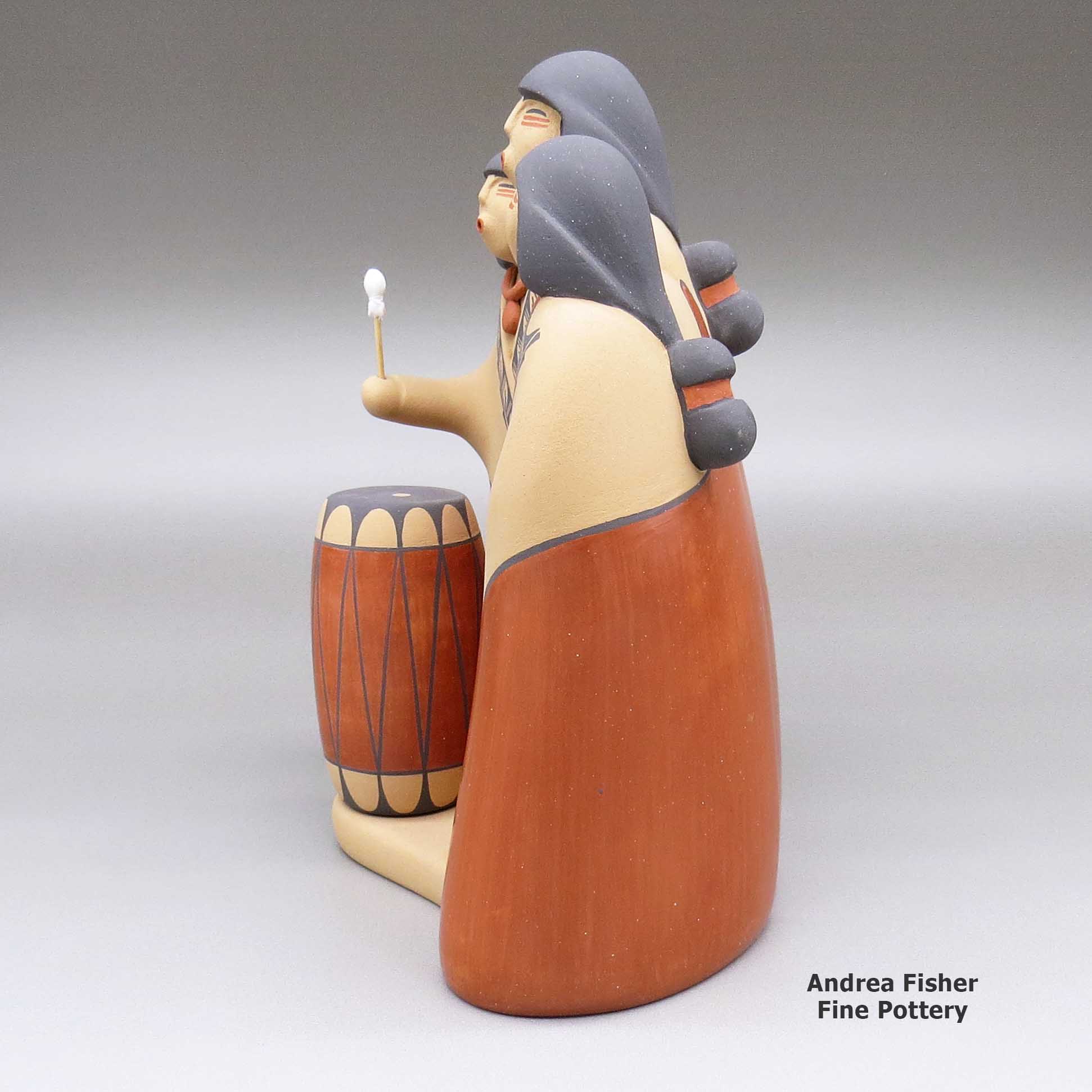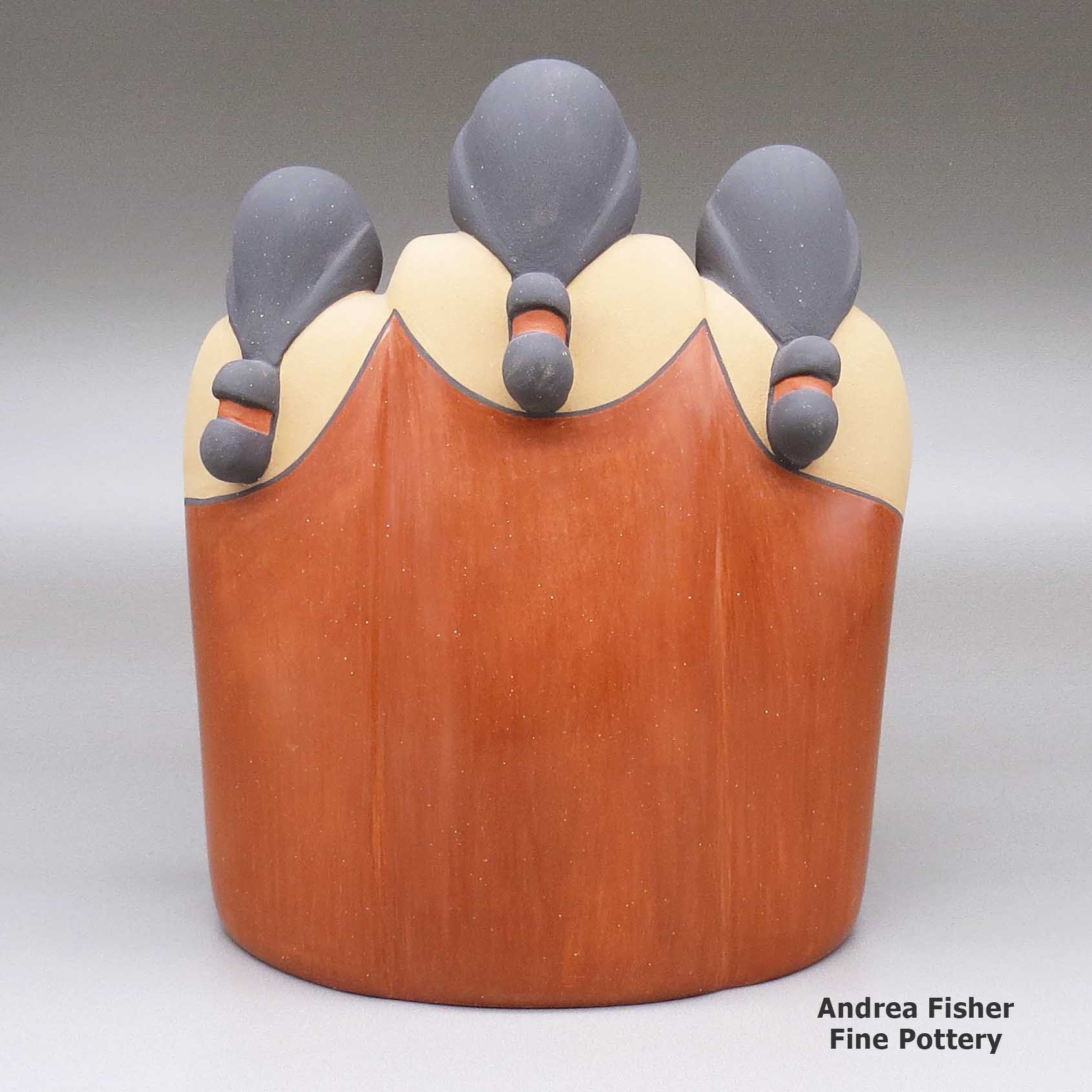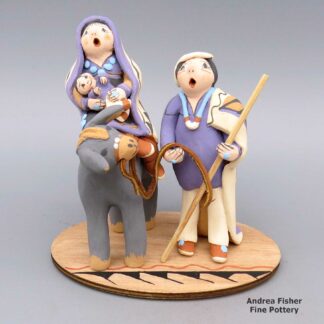| Dimensions | 5.25 × 8 × 9.75 in |
|---|---|
| Condition of Piece | Very good, normal wear |
| Signature | Maxine Toya Jemez, with cornstalk hallmark |
Maxine Toya, zzje3b511, Figure with three people
$2,500.00
A polychrome figure depicting three singing Pueblo dancers standing around a drum, with a painted cornstalk and geometric design
In stock
Brand
Toya, Maxine
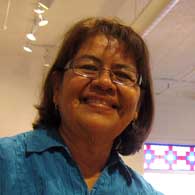 The daughter of famous Jemez Pueblo potter Marie G. Romero, Maxine grew up surrounded by some of the most accomplished of today's Jemez potters. Among the potters in her family: Laura Gachupin, Persingula Gachupin, Bertha Gachupin, Virginia Fragua and now, Maxine's children Camilla and Dominique.
The daughter of famous Jemez Pueblo potter Marie G. Romero, Maxine grew up surrounded by some of the most accomplished of today's Jemez potters. Among the potters in her family: Laura Gachupin, Persingula Gachupin, Bertha Gachupin, Virginia Fragua and now, Maxine's children Camilla and Dominique.Maxine has been producing pottery since she was 20 years old and over the years has earned numerous First, Second and Third Place awards in shows at the Eiteljorg Museum of American Indians and Western Art in Indianapolis and the Santa Fe Indian Market. She has also earned awards for Best in Pottery Division and for Most Creative Design.
Her favorite shapes to make are clay sculptures, large singular figures as seen in her famed nativity sets. Her nativities offer beautifully polished robes and peaceful and serene human and animal faces. She also usually decorates her pieces with traditional Jemez designs.
She told us she originally got much of her inspiration from Apache sculptor Allan Houser. She says she also gets inspiration from her mother and from the works of other potters.
Maxine tells us she loves the feel of clay: "It is so alive and it wants to speak through me." Working with clay is her favorite form of therapy.
Some Exhibits that featured Maxine's work
- Gifts from the Community. Heard Museum West. Surprise, Arizona. April 12, 2008 - October 12, 2008
- Images, Artists, Styles: Recent Acquisitions from the Heard Museum Collection. Heard Museum North. Scottsdale, Arizona. July - December 2001
- Bridges and Boundaries (Brucken und Abgrenungen). Peiper-Riegraf Gallery. Frankfurt, Germany. October 9, 1995 - November 6, 1995. Note: artists include David Bradley, Rick Bartow, Bob Haozous, Edgar Heap of Birds, Delbridge Honanie, David Johns, Mike Kabotie, Linda Lomahaftewa, Jean LaMarr, Dan Namingha, Jaune Quick-to-see Smith, Darren Vigil-Gray, Maxine Toya and Emmi Whitehorse
Some awards earned by Maxine
- 2023 Santa Fe Indian Market, Classification IIB, Category 605 - Figures/Manas, First Place
- 2022 Heard Museum Guild Indian Fair & Market: Honorable Mention for Classification II - Pottery, awarded for collaborative artwork with Dominique Toya. Awarded for artwork: Untitled
- 2019 Santa Fe Indian Market, Classification II - Pottery, Division B - Traditional Painted Pottery, Category 604 - Painted polychrome pottery in the style of Jemez, Zia, Santa Ana, Sandia, San Felipe, Isleta, any form: Second Place shared with Dominique Toya
- 2019 Santa Fe Indian Market, Classification II - Pottery, Division B - Traditional Painted Pottery, Category 606 - Traditional storytellers, including sets: Second Place
- 2019 Heard Museum Guild Indian Arts Fair & Market, Classification II - Pottery, Division A - Painted, native clay, hand build, fired out-of-doors: First Place. Awarded for collaborative artwork with Dominique Toya: Traditional Storage Jar
- 2018 Santa Fe Indian Market, Classification II - Pottery, Division B - Traditional Painted Pottery, Category 604 - Painted polychrome pottery in the style of Jemez, Zia, Santa Ana, Sandia, San Felipe, Isleta, any form: First Place. Shared First Place with Dominique Toya
- 2018 Santa Fe Indian Market, Classification II - Pottery, Division B - Traditional Painted Pottery, Category 605 - Figures/Manas: Second Place
- 2018 Santa Fe Indian Market, Classification II - Pottery, Division B - Traditional Painted Pottery, Category 606 - Traditional storytellers, including sets: First Place
- 2017 Santa Fe Indian Market: Classification II - Pottery, Division B - Traditional, Category 606 - Traditional storytellers, including sets: Second Place
- 2017 Santa Fe Indian Market: Classification II - Pottery, Division B - Traditional, Category 606 - Traditional storytellers, including sets: Honorable Mention. August 2017
- 2017 Heard Museum Guild Indian Fair & Market, Classification II - Pottery, Division D - Figurative, Native Clay, Hand Built: Second Place. Awarded for collaborative artwork with Nancy Youngblood: "Margaret Tafoya"
- 2012 Heard Museum Guild Indian Fair & Market, Classification Honorable Mention.II - Pottery, Division A - Traditional, native clay, hand built, painted: Honorable Mention. Awarded for collaborative artwork "Generation" with Dominique Toya
- 2004 Santa Fe Indian Market, Classification II - Pottery, Division F - Traditional pottery, painted designs on matte or semi-matte surface, all forms except jars, Category 1306 - Storyteller: First Place
- 2004 Santa Fe Indian Market, Classification II - Pottery, Division G - Non-traditional pottery, using traditional materials and techniques, any form or design, Category 1405 - Figures, all one piece, can include storyteller bowls: Second Place
- 2004 Santa Fe Indian Market, Classification II - Division H - Non-traditional pottery using traditional materials and techniques with non-traditional decorative elements, Category 1504 - Single figures: Second Place
- 2000 Santa Fe Indian Market, Classification II - Pottery, Division F - traditional pottery, all forms except jars, Category 1310 - storytellers (all one piece): First Place
- 1978 Heard Museum Guild Indian Arts and Crafts Exhibit, Classification VII - Pottery, Division B - Contemporary: Honorable Mention. Awarded for artwork: Kiva with clowns
A Short History of Jemez Pueblo

As the drought in the Four Corners region deepened in the late 1200s, several clans of Towa-speaking people migrated southeastward, across the Upper San Juan River into the Gallina Highlands, then over the hill to the Canyon de San Diego area in the southern Jemez mountains. Other clans of Towa-speaking people migrated southwest and settled in the Jeddito Wash area in northeastern Arizona, below Antelope Mesa and southeast of Hopi First Mesa. The large migrations out of the Four Corners area began around 1250 and the area was almost entirely depopulated by 1300. The Towa-speakers who went southeast were pretty much settled by about 1350.
Archaeologist Jesse Walter Fewkes argues that pot sherds found in the vicinity of the ruin at Sikyátki (near the foot of Hopi First Mesa) speak to the strong influence of earlier Towa-speaking potters on what became "Sikyátki Polychrome" pottery (Sikyátki was a village at the foot of First Mesa, destroyed by other Hopis around 1625). Fewkes maintained that Sikyátki Polychrome pottery was the finest ceramic ware ever made in prehistoric North America.
Francisco de Coronado and his men arrived in the Jemez Mountains of Nuevo Mexico in 1539. By then the Jemez people had built several large masonry villages among the canyons and on some high ridges in the area. Their population was estimated at about 30,000 and they were among the largest and most powerful tribes in northern New Mexico. Some of their pueblos reached five stories high and contained as many as 3,000 rooms.

Because of the nature of the landscape they inhabited, agriculture was hard. The Jemez had always been travelers and traders. Their people had traded goods all over the Southwest and northern Mexico for generations. In those days they also made a lot of pottery and trading pottery with Zia and Santa Ana Pueblos for food was a brisk business.
The arrival of the Spanish was disastrous for the Jemez and they resisted the Spanish with all their might. That led to many atrocities against the tribe until they rose up in the Pueblo Revolt of 1680 and helped evict the Spanish from northern New Mexico. With the Spanish gone, the Jemez destroyed much of what they had built on Jemez land. Then they concentrated on preparing themselves for the eventual return of the hated priests and the Spanish military.
The Spanish returned in 1692 and their efforts to retake northern New Mexico bogged down as the Jemez fought them doggedly for four years. In 1696 many Jemez came together, killed a Franciscan missionary and then fled to join their distant relatives in the Jeddito Wash area in northeastern Arizona. They remained at Jeddito Wash for several years before returning to the Jemez Mountains.
It was around that time that the Hopi themselves destroyed Awatovi, the largest pueblo in the Hopi area (many of the people of Awatovi also spoke Towa). A Spanish missionary with a few soldiers had appeared at Awatovi in 1696 and forced the rebuilding of the mission. He also started getting people into the church. The leader of Awatovi went to the other Hopi pueblos and told their leaders that his people had strayed too far: they must be destroyed to cleanse the Earth of their sins. In the winter of 1700-1701, men from Walpi, Oraibi and a couple other pueblos invaded Awatovi while the men were in their kivas. The invaders pulled the ladders out of the kivas, poured baskets of hot red chile peppers and burning pine pitch down, then killed almost everyone. When the frenzy was over they burned the pueblo down and salted the earth around it so it would never be reoccupied.
On their return to the Jemez Mountains around 1700, the Jemez people built the pueblo they now live in (Walatowa: The Place) and made peace with the Spanish authorities. Even today, there are still strong ties between the Jemez and their cousins on Dineh territory at Jeddito.
East of what is now Santa Fe is where the ruins of Pecos Pueblo (more properly known as Cicuyé) are found. Cicuyé was a large pueblo housing up to 2,000 people at its height. The people of Cicuyé were the easternmost speakers of the Towa language in the Southwest. After the Pueblo Revolt, the Pecos area fell on increasingly hard times (constant Apache and Comanche raids, European diseases, increasing drought). The pueblo was finally abandoned in 1838 when the last 17 residents relocated to Jemez. The Governor of Jemez welcomed them and allowed them to retain many of their Pecos tribal offices (governorship and all). Members of former Pecos families still return to the site of Cicuyé every year to perform religious ceremonies in honor of their ancestors.

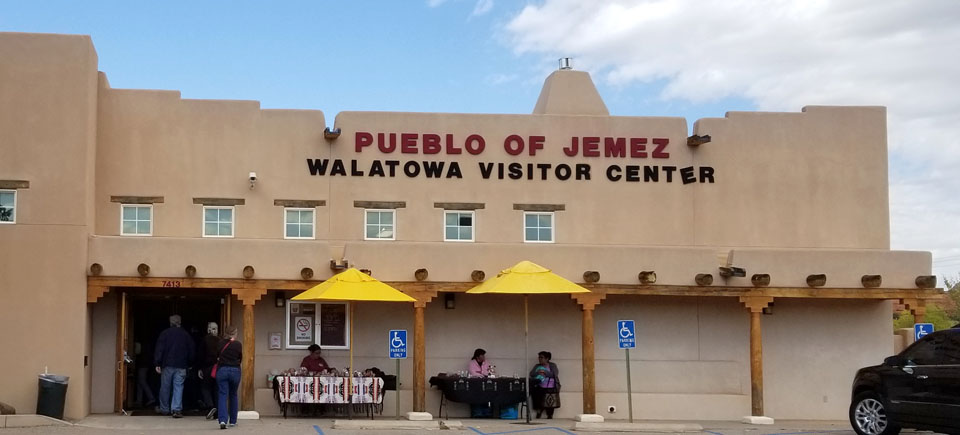

For more info:
Pueblos of the Rio Grande, Daniel Gibson, ISBN-13:978-1-887896-26-0, Rio Nuevo Publishers, 2001
Prehistoric Hopi Pottery Designs, Jesse Walter Fewkes, ISBN-0-486-22959-9, Dover Publications, Inc., 1973
Photos are our own. All rights reserved.
About Figures and Figurines
Generally, "Figure" denotes a real or mythic creature, like an owl or human or katsina or Corn Maiden. Whether form or decoration, all Puebloan pottery figures are meant to invoke particular spiritual essences. That's why "effigy" is used almost as often as "figure" to denote these pieces.
Among most Puebloans, the figure of an owl, for example, signifies all the physical and spiritual aspects attributed to the owl. It's a form of prayer to the spirit of "Owl" and the appropriately decorated physical form is meant to make that spirit manifest. However, to the Zuni people an owl is a good omen and to the Tewa people, an owl is a bad omen. Some potters at Santa Clara have made owls anyway, they just shaped and decorated them to reflect that "badness."
That explanation may make more sense in the case of the Corn Maiden as she is a mythic entity whose existence revolves around the most ubiquitous food staple in the Puebloan world: corn (maize). All representations of the Corn Maiden are meant to invoke her benevolence and abundance for their people. Because of her mythical/spiritual nature, different pueblos have slightly different physical forms for her but they all incorporate the basic form of a female human face on an ear of corn.
The potters of Tesuque turned out thousands of muna figures (also known as rain gods)for several decades, until they virutally burned out their pottery tradition. These muna had very specific shapes but were decorated with everything from micaceous slips to incised lines to polychrome geometric designs to poster paints. They were also made purely for domestic American consumption, sometimes delivered by the barrel to be used as prizes and giveaways.
The Storyteller is another figure based on Puebloan tradition: a tribal elder singing the stories of the tribe's oral history to the children. The original was based on the traditional cultural story: a grandfather singing his part of the story in his native language so the children learn both the language and their identity against the backdrop of that history. Shortly, the storyteller form was duplicated in several other pueblos, each pueblo's potters adapting the form to their local situation. In some places, the grandmother became the primary sex of their storytellers. At Jemez, that responsibility was shared between grandmothers and grandfathers. Then some potters in search of new niches in the marketplace branched into making "spirit figure" storytellers, like eagles, ravens, hummingbirds, cats and dogs. Some Zuni potters have made storyteller owls.
Similar to the Storyteller is the Story Time: a set of separate children displayed around a larger central singing figure.
The Nativity set (also known as nacimiento) is a set of figures based on the intersection of Puebloan mythologies and stories they heard from Christian missionaries. Those potters who make them also tend to favor dress, shapes and designs that reflect their own heritage(s). The first few nativities made at Tesuque Pueblo were decorated with Spanish colonial costumes but that soon changed and every nativity made since has a distinct blend of Native American and Christian, with no other reference to colonialism. The "Singing Angel" (a single standing figure with outstretched wings and hands clasped together in prayer) and "Flight to Egypt" (usually depicting Mary with a baby Jesus on the back of a donkey and a standing Joseph nearby holding the rein) are similar mixes of tribal and Christian figures. The miniature nativities made by Santa Clara/Dineh artist Linda Askan clearly show Dineh religious influence in the headresses worn by Joseph, the angel and the three wise men. At the same time, the Dineh Folk Art nativities made by Jonathan Chee are based on the realities of daily Dineh life: the three wise men wear wide-brim hats and blue jeans, and bring gifts of salt and 50-pound bags of flour.
Pueblo and Dineh artists also make a full zoo of domesticated, farm and wild animal figures: horses, donkeys, cows, chickens, pigs, sheep, turkeys, giraffes, elephants, dogs, cats, mermaids, women-dressed-up-and-taking-selfies and cowboys among them.
About Pueblo Dancer Designs
Every pueblo that has an active kiva also has one or more active clans among the villagers. Each of those clans has its own part to play in the kiva rites of the village, and that usually includes participating in some of the sacred dances and ceremonies that occur through the year. For most of these dances, the participants don the costume (and mask or tablito, if there is one) of the spirit they are representative of in the dance. The tradition of depicting those spirits goes back more than 1500 years, to the early days of the Twin Warrior stories. Today, some pueblos allow their artists to make images of those dancers and some do not.
Benigna Medina Madelena Family Tree - Jemez Pueblo
Disclaimer: This "family tree" is a best effort on our part to determine who the potters are in this family and arrange them in a generational order. The general information available is questionable so we have tried to show each of these diagrams to living members of each family to get their input and approval, too. This diagram is subject to change should we get better info.
Benigna Medina was born and raised at Zia Pueblo, learning to make pottery the Zia way as she grew up. Then she married Ramon Madelena from Jemez Pueblo and moved to his home there. She infused the Jemez potters of the time with Zia methods, forms and designs, strengthening a very weak Jemez tradition: the Spanish had virtually destroyed all Jemez traditions 200 years before and recovery was very hard.
- Benigna Medina Madelena (c.1880-) & Ramon Madelena
- Persingula M. Gachupin (ca. 1910-1994) & Joe R. Gachupin
- Marie G. Romero (1927-)
- Laura Gachupin (1954-)
- Benina Foley (1982-)
- Gordon Foley (1975-)
- Maxine Toya (1948-)
- Dominique Toya (1971-)
- Mariam Toya (1974-)
- Laura Gachupin (1954-)
- Leonora G. Fragua (1938-)
- Matthew Fragua (1963-)
- Virginia Ponca Fragua (1961-) & M. Pecos
- Brandon Pecos Fragua (1993-)
- Bertha Gachupin (1954-)
- Antonia Gachupin (1970s-) & Albert Yepa
- Kajzia Gachupin (1991-)
- Kiana Gachupin (1993-)
- Okoya Gachupin
- Antonia Gachupin (1970s-) & Albert Yepa
- Marie G. Romero (1927-)
- Elcira Madelena (c.1915-)
- Mary Rose Toya
- Eloise Toya
- Norma Toya
- Mary Rose Toya
- Josephita Madelena
- Reyes Marie Madelena-Butler (1938-)
- Shannon Madelena-Ellington
- Reyes Marie Madelena-Butler (1938-)

